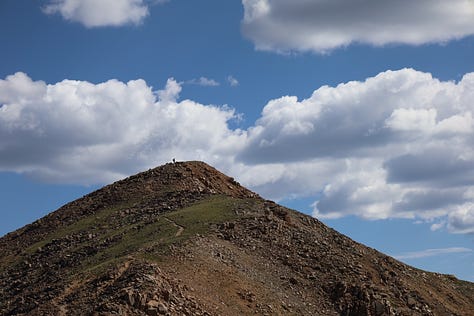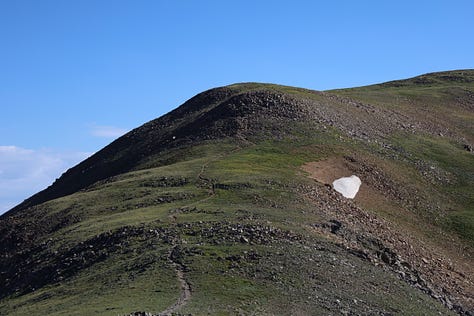Photographic Overkill: why Sometimes it's Better to Put the Camera down
A recent hike left me with a lot of pictures, but hardly anything to say. Here's how photography has started to reshape our outdoor experiences for the worse:
The First Mile Always Feels the Hardest
I allowed too much time to pass since my last trip to the mountains, and the prospect of a gorgeous wildflower bloom was more than enough to lure me back.
But to get to the gorgeous, green landscape carpeted in blossoms, I first had to make the steep climb onto the shoulder of Sniktau Mountain. The early stages of the climb from the trailhead tax me the most.
The trail is vague and shapeless, cutting straight up the mountainside over loose dirt and gravel. I try to find stable footing, but it’s hard to tell the sturdy rocks apart from the loose ones.
The cold morning air nips at the tops of my exposed ears. I trade my ballcap for a knit hat, tugging the edges down. I try to sip water between shallow gasps for air, waiting for my heart to slow from its frantic pace.
I inwardly groan when I notice I’m still within shouting distance of the trailhead parking lot. I could’ve sworn I’d gone farther.
Things improve up on the actual ridgeline. Here, at a cluster of cairns, the trails branch. To the right, the path meanders down a saddleback to Cupid, then Grizzly, and eventually Torreys Peak. Straight ahead, the branch snaked across a slanted meadow of gold and white flowers, climbing skyward.
The valley between our path, and the craggy Kelso Ridge stands wide, and deep. At the bottom sits a snowmelt lake, feeding into a meandering river that snakes down through the trees.
After reaching the rounded false summit, the true challenge presents itself. The way to the peak unfolded like a stairway to heaven, skirting the edge of a steep, scree-covered slope.
Standing at the top, I can barely make out—hang on, should I put a picture here? It hasn’t even been two paragraphs, maybe I should wait until the part about the paragliders. There’s too many good photos to pick from!
AGH! Fine, I’ll just throw them all in!









I swear I didn’t set out to write meta commentary when I started this essay, but then I started looking through my photo library and found myself completely overwhelmed. How did I take so many on such a short hike? Many of them were nearly identical copies of the same view; just with different shutter speed, aperture settings, and framing.
Filling a memory card is easy. I can hold down the shutter button on my Canon and take more pictures in two seconds, than could fit on an entire roll of film. This certainly takes the pressure off in the field, where the only remaining constraint is battery life.
When I’m trying to snap something good to share with you, I can opt for the “grab everything while you’re here, sort it out later,” approach.
Then later actually comes; I get home, and have to deal with this:
Narrowing down hundreds of pictures to just a few is tough. It’s also a massive distraction. 95% of American adults own a cellphone — 85% say they have a smartphone.1 That means virtually everyone has a pretty good camera with them at all times. So both the ability, and temptation constantly exist to pull out the phone and start recording.
There are no more “mom, get the camera!” moments; no sense of urgency that the thing you’re trying to capture is special and unique — because it’s not. We capture everything, and then tell ourselves we’ll look back on it at some hypothetical future time that never comes.
For what it’s worth, I find the hikes where I take the most pictures, are the ones I have the hardest time writing about. Take last week’s piece for example: this trek happened 14 years ago. Between our entire group, we took less than a dozen photos. But I still remember it clearly enough to recreate our exact route, on a map, from memory.
Compare that to my trip up Evergreen Mountain: 99 pictures and no real lingering thoughts. Maybe it’s because I’m deferring the experience and introspection on my adventures to later. “I’ll get such good photos. I can reflect on them at home.”
Modern photography feels more preventative than reactionary. We’re not conscientiously committing something interesting to film. We’re snapping shots constantly to make sure we don’t miss anything. It’s like the fear of missing out, or “FOMO,” but for photography. A kind of “Photo-MO,” if you’ll indulge me. Actually, wait — it might be time to coin another new phrase:
PhotoMO
noun
1. The compulsion to take pictures of everything in the hopes of inadvertently capturing an image of something incredible2. The strong desire to thoroughly photograph an event, trip, or destination for the primary purpose of later proving you were there
An Example of “PhotoMO” used in a sentence:
When visiting the Grand Canyon, Marcus and Amber took thousands of Instagram selfies to ease their creeping feelings of PhotoMO.
Seriously, I bet you’ve got thousands of photos on your camera roll. When is the last time you’ve looked back on a single one, other than to choose some red meat to throw on the social media feed?
A former friend of mine from high school was extremely into photography. She owned classic cameras and developed her own film.
Cropping photos after they were taken, to her, was the same as digitally editing something unwanted out of the background. “You make your artistic choice when you compose the shot and open the shutter. Not after,” she said.
Sure, all of this felt a bit pretentious at the time. But looking back, there’s something inspiringly deliberate about treating each picture with care and intention.
You only get 36 of these. Make ‘em count.
How oddly liberating.
After I publish this piece, I’m going to go somewhere on some adventure, and commit to taking just one single picture. I’ll share it with the Summit Squad after the fact. (if you’d like to join our little group, check out the About Page for more information.)
It’ll be nice to see more of the view with my own eyes.
I Want to Hear from You
Do we take too many pictures? Have cameras, AKA phones, become more of a distraction to our enjoyment? Or will I eat my own words years down the road, when I have thousands of pictures to look back on my adventures fondly?
If you enjoyed this essay, consider sharing it with a friend. I don’t have much of a marketing budget, and this is a great way to help me reach more people.
If you’re here because someone shared this post with you — consider subscribing to get more content about the outdoors, and help support independent journalism.
According to data from Pew Research







Hi Cole, our minds eye gives us the best views and memories….plus no worries of iCloud account is full need to upgrade. Of course pictures capture special events, family, friends, scenery for others to enjoy as well….but try not to lose the actual moment.
Ugh. I feel this too deeply. I LOVE talking pictures and always take too many. But I love the way they help me tell a story and keep a visual of the memory. Figuring out the balance is tough. One thing I did realize this year, however: no one on my social media page really cares too see ALL of my vacation photos. That epiphany made it much easier to take Facebook off of my phone.